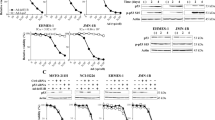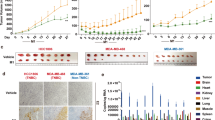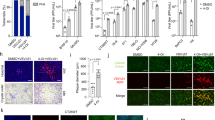Abstract
Our previous studies demonstrated that adenovirus-mediated overexpression of melanoma differentiation-associated gene-7 (Ad-mda7) leads to rapid induction of double-stranded RNA-dependent protein kinase (PKR) and activation of its downstream targets, resulting in apoptosis induction in human lung cancer cells. Here, we report that Ad-mda7 and the benzoquinone ansamycin geldanamycin (GA) interact in a highly synergistic manner to induce cell death in human lung cancer cells. Co-administration of Ad-mda7 and GA did not modify expression of MDA-7, and was not associated with further PKR induction and activation; instead the enhanced cytotoxicity of this combination was associated with inactivation of AKT by GA. By surface staining using anti-E-cadherin monoclonal antibody and flow cytometry, we found that treatment with the combination of Ad-mda7 and GA increased E-cadherin levels in these cancer cells. Ad-mda7 and GA cotreatment also inhibited lung cancer cell motility by increasing the β-catenin/E-cadherin association. Moreover, combination of GA derivative 17-allyl-amino, 17-demethoxygeldanamycin (17AAG), with Ad-mda7 resulted in enhancement of cell death in A549 and H460 human lung cancer cells.
This is a preview of subscription content, access via your institution
Access options
Subscribe to this journal
Receive 12 print issues and online access
$259.00 per year
only $21.58 per issue
Buy this article
- Purchase on Springer Link
- Instant access to full article PDF
Prices may be subject to local taxes which are calculated during checkout




Similar content being viewed by others
References
Jiang H, Lin JJ, Su ZZ, Goldstien NI, Fisher PB . Subtraction hybridization identifies a novel melanoma differentiation associated gene, mda-7, modulated during human melanoma differentiation, growth and progression. Oncogene 1995; 11: 2477–2486.
Sarkar D, Su ZZ, Lebedeva IV, Savane M, Gopalkrishman RV, Dent P et al. mda-7 (IL-24): Signaling and functional roles. Biotechniques Suppl 2002; 10: 30–39.
Mhashilkar AM, Stewart AL, Sieger K, Yang HY, Khimani AH, Ho I et al. MDA-7 negatively regulates the beta-catenin and PI3K signaling pathways in breast and lung tumor cells. Mol Ther 2003; 8: 207–219.
Mhashilkar AM, Schrock RD, Hindi M, Liao J, Sieger K, Kourouma F et al. Melanoma differentiation associated gene (mda7): a novel anti-tumor gene for cancer gene therapy. Mol Med 2001; 7: 271–282.
Chada S, Mhashilkar AM, Ramesh R, Mumm JB, Sutton RB, Bocangel D et al. Bystander activity of Ad-mda7: MDA-7 protein kills melanoma cells via an IL-20 receptor-dependent but STAT3-independent mechanism. Mol Ther 2004; 10: 1085–1095.
Pataer A, Vorburger ST, Barber GN, Xia W, Chiao P, Ellis LM et al. Adenoviral transfer of the melanoma differentiation-associated gene 7 (mda7) induces apoptosis of lung cancer cells via up-regulation of the double-stranded RNA dependent protein kinase (PKR). Cancer Res 2002; 62: 2239–2243.
Williams B . Signal integration via PKR. Sci STKE 2001; 89: RE2.
Barber GN . Host defense, viruses and apoptosis. Cell Death Diff 2001; 8: 113–126.
Jagus R, Joshi B, Barber GN . PKR, apoptosis and cancer. Int J Biochem Cell Biol 1999; 31: 123–138.
Donze O, Abbas-Terki T, Picard D . The Hsp90 chaperone complex is both a facilitator and a repressor of the dsRNA-dependent kinase PKR. EMBO J 2001; 20: 3771–3780.
Solit DB, Scher HI, Rosen N . Hsp90 as a therapeutic target in prostate cancer. Semin Oncol 2003; 30: 709–716.
Vorburger SA, Pataer A, Yoshida K, Barber GN, Xia W, Chiao P et al. Role for the double-stranded RNA activated protein kinase PKR in E2F-1-induced apoptosis. Oncogene 2002; 21: 6278–6288.
Bonvini P, An WG, Rosolen A, Nguyen P, Trepel J, Garcia de Herreros A et al. Geldanamycin abrogates ErbB2 association with proteasome-resistant beta-catenin in melanoma cells, increases beta-catenin-E-cadherin association, and decreases beta-catenin-sensitive transcription. Cancer Res 2001; 61: 1671–1677.
Sieger KA, Mhashilkar AM, Stewart A, Sutton RB, Strube RW, Chen SY et al. The tumor suppressor activity of MDA-7/IL-24 is mediated by intracellular protein expression in NSCLC cells. Mol Ther 2004; 9: 355–367.
Ramesh R, Mhashilkar AM, Tanaka F, Saito Y, Branch DC, Sieger K et al. Melanoma differentiation-associated gene 7/interleukin (IL)-24 is a novel ligand that regulates angiogenesis via the IL-22 receptor. Cancer Res 2004; 63: 5105–5113.
Taylor DR, Shi ST, Romano PR, Barber GN, Lai MM . Inhibition of the interferon-inducible protein kinase PKR by HCV E2 protein. Science 1999; 285: 107–110.
Maloney A, Workman P . HSP90 as a new therapeutic target for cancer therapy: The story unfolds. Expert Opin Biol Ther 2002; 2: 3–24.
Sausville EA, Tomaszewski JE, Ivy P . Clinical development of 17-allylamino, 17-demethoxygeldanamycin. Curr Cancer Drug Targets 2003; 3: 377–383.
Downward J . PI 3-kinase, Akt and cell survival. Semin Cell Dev Biol 2004; 15: 177–182.
Luo J, Manning BD, Cantley LC . Targeting the PI3K-Akt pathway in human cancer: rationale and promise. Cancer Cell 2003; 4: 257–262.
Pandey P, Saleh A, Nakazawa A, Kumar S, Srinivasula SM, Kumar V et al. Negative regulation of cytochrome c-mediated oligomerization of Apaf-1 and activation of procaspase-9 by heat shock protein 90. EMBO J 2000; 19: 4310–4322.
Moon RT, Kohn AD, De Ferrari GV, Kaukas A . WNT and beta-catenin signalling: diseases and therapies. Nat Rev Genet 2004; 5: 691–701.
Pece S, Chiariello M, Murga C, Gutkind JS . Activation of the protein kinase Akt/PKB by the formation of E-cadherin-mediated cell-cell junctions. Evidence for the association of phosphatidylinositol 3-kinase with the E-cadherin adhesion complex. J Biol Chem 1999; 274: 19347–19351.
Kobielak A, Fuchs E . Alpha-catenin: at the junction of intercellular adhesion and actin dynamics. Nat Rev Mol Cell Biol 2004; 5: 614–625.
Kamal A, Thao L, Sensintaffar J, Zhang L, Boehm MF, Fritz LC et al. A high-affinity conformation of Hsp90 confers tumour selectivity on Hsp90 inhibitors. Nature 2003; 425: 407–410.
Enmon R, Yang WH, Ballangrud AM, Solit DB, Heller G, Rosen N et al. Combination treatment with 17-N-allylamino-17-demethoxy geldanamycin and acute irradiation produces supra-additive growth suppression in human prostate carcinoma spheroids. Cancer Res 2003; 63: 8393–8399.
Solit DB, Basso AD, Olshen AB, Scher HI, Rosen N . Inhibition of heat shock protein 90 function down-regulates Akt kinase and sensitizes tumors to Taxol. Cancer Res 2003; 63: 2139–2144.
Rahmani M, Yu C, Dai Y, Reese E, Admed W, Dent P et al. Coadministration of the heat shock protein 90 antagonist 17-allylamino- 17-demethoxygeldanamycin with suberoylanilide hydroxamic acid or sodium butyrate synergistically induces apoptosis in human leukemia cells. Cancer Res 2003; 63: 8420–8427.
Acknowledgements
This work was supported by grants from the National Cancer Institute and the National Institutes of Health (P01 CA78778-01A1) (JAR, SGS) SPORE 2P50-CA70970-04 and by SBIR 1R43 CA86587-1 (SGS, SC); by gifts to the Division of Surgery from Tenneco and Exxon for the Core Laboratory Facility; by the MD Anderson Cancer Center Support Core Grant (CA 16672); by donations from the Charles Rogers Memorial and Gene Therapy Donor funds; by a grant from the Tobacco Settlement Funds as appropriated by the Texas State Legislature (Project 8); by the WM Keck Foundation; and by a sponsored research agreement with Introgen Therapeutics Inc. (SR93-004-1). We thank Alma Vega and Debbie Smith for their assistance in preparation of the manuscript.
Author information
Authors and Affiliations
Corresponding author
Rights and permissions
About this article
Cite this article
Pataer, A., Bocangel, D., Chada, S. et al. Enhancement of adenoviral MDA-7-mediated cell killing in human lung cancer cells by geldanamycin and its 17-allyl- amino-17-demethoxy analogue. Cancer Gene Ther 14, 12–18 (2007). https://doi.org/10.1038/sj.cgt.7700989
Received:
Revised:
Accepted:
Published:
Issue Date:
DOI: https://doi.org/10.1038/sj.cgt.7700989
Keywords
This article is cited by
-
Combination of adenoviruses expressing melanoma differentiation-associated gene-7 and chemotherapeutic agents produces enhanced cytotoxicity on esophageal carcinoma
Cancer Gene Therapy (2014)
-
Heat-shock protein 90 inhibitors synergistically enhance melanoma differentiation-associated gene-7-mediated cell killing of human pancreatic carcinoma
Cancer Gene Therapy (2013)
-
Dual induction of PKR with E2F-1 and IFN-α to enhance gene therapy against hepatocellular carcinoma
Cancer Gene Therapy (2008)
-
MDA-7/IL-24, a novel tumor suppressor/cytokine is ubiquitinated and regulated by the ubiquitin–proteasome system, and inhibition of MDA-7/IL-24 degradation enhances the antitumor activity
Cancer Gene Therapy (2008)



